Propiedades y características del Hielo [ES // EN]
Cuando estamos en una reunión y se desea entablar una conversación personal con otras personas o invitados, muchas veces no sabemos cómo empezar dicha tertulia. Se dice comúnmente “romper el hielo”, debido a que en algunos casos se entra en pánico al hablar en público, o se manifiesta una sutil vergüenza al dirigirse a la concurrencia que no se conoce, haciéndose difícil entrar e interrumpir el ambiente de conversación. Este apartado ha servido para “romper el hielo” y dar paso a la definición del “agua convertida en un cuerpo sólido y cristalino por un descenso suficiente de temperatura o por aumento de presión”.
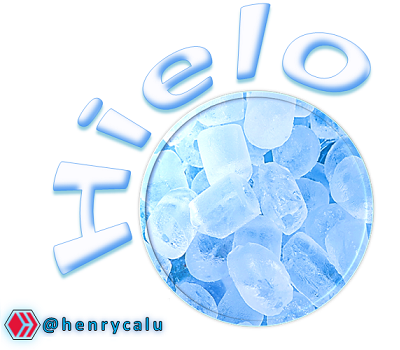
Geológicamente, se puede hablar del hielo natural, aquel que fue formado hace millones de años en los casquetes polares. El Glaciar poseedor de más de mil metros de espesor, el cual cubre extensas regiones y cuyo movimiento tiene lugar hacia los bordes. Tiene solamente Morrena de fondo y frente. Pero si se menciona el hielo artificial, se está exponiendo la versión de un hielo común (casero) hecho en barras. Dentro de los electrodomésticos caseros se tiene un aparato denominado refrigerador (nevera, hielera, congelador, etc.); en el cual se colocan cubetas llenas de agua (rodeadas con serpentín enfriador) que al enfriarse se obtienen cubitos de hielo.
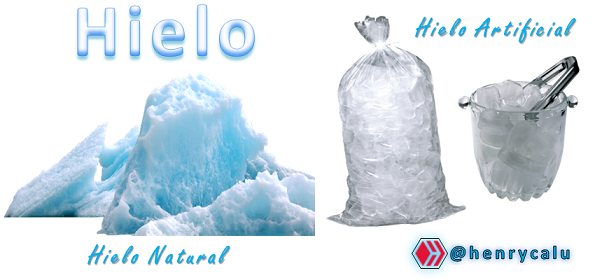
En muchos lugares del mundo se presenta gran variedad de técnicas para hacer hielo. Un ejemplo de ello, en la India: en ciertos lugares se obtiene dejando en horas de la noche, a la intemperie, vasijas porosas llamadas “Chattis”.
De forma industrial, se puede obtener hielo en barra hasta 100 kg enfriando agua contenida en moldes paralelepipédicos por medio de salmuera, soluciones de cloruro de calcio a -18°C. Ordinariamente, el hielo así resultante es más o menos opaco por las pequeñas burbujas de aire que contiene; además, sí el agua no es destilada las sales se concentran en el núcleo del bloque congelado formando el “corazón del hielo”.
Modernamente se produce hielo en escamas de forma continua mediante un tambor muy refrigerado y sumergido parcialmente en agua.

Se tiene otro nombre: hielo seco. Es una técnica de hacer un tipo de hielo que simplemente es Dióxido de Carbono solidificado (también conocido como Anhídrido Carbónico), el cual resulta de comprimir la nieve carbónica. Tiene un gran poder frigorífico de 152 fg (frigorías) por kilogramo, casi el doble que el hielo común, pero su costo es muy elevado. Sin embargo, presenta la ventaja que al calentarse (no se derrite) se transforma directamente en gas. Es empleado por la industria, especialmente, para refrigerar productos alimenticios por períodos relativamente breves.

Exponiendo desde un punto de vista químico, se puede decir que el hielo es agua sólida. Existen varias modificaciones alotrópicas, y algunas, obtenibles a altas presiones y temperatura mayor que 0°C, son más densas que el agua. El hielo común funde a 0°C (por definición del punto cero de la escala centígrada) y a esa temperatura tiene una densidad de 0,9175 g/cm3. Es transparente e incoloro o bajo espesores considerables, ligeramente azulado.
En la red cristalina, cada átomo de oxígeno está rodeado de otros cuatro átomos de oxígeno, situados en relación con el primero como los vértices de un tetraedro con respecto a su centro. En las líneas de unión entre cada átomo de oxígeno y los que lo rodean hay átomos de hidrógeno (uno en cada línea). Para cada oxígeno, dos de los hidrógenos están próximos, formando con él la molécula de agua, y los otros dos están próximos a otros oxígenos; cada hidrógeno está así ligado covalentemente a un oxígeno, con el cual forma parte de una molécula de agua, y por unión electrónica (unión tipo hidrógeno) está ligado a otro oxígeno más lejano, perteneciente a otra molécula de agua. Esta estructura se prolonga a lo largo de todo el cristal, en sus tres dimensiones.
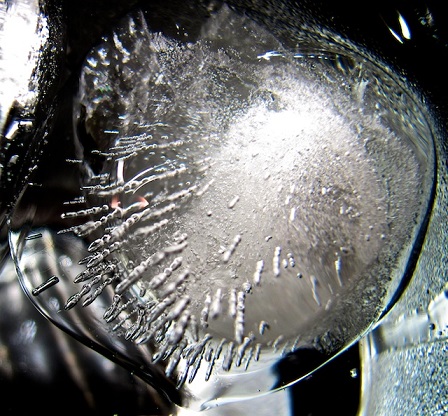
Fotografía que muestra detalles de un cubo de hielo bajo aumento. El hielo 1h es la forma de hielo comúnmente vista en la Tierra
Como el hielo es menos denso que el agua líquida, disminuye el volumen al fundirse; además, su punto de fusión desciende cuando se eleva la presión, lo cual explica el fenómeno del movimiento de los glaciares, y algunas experiencias demostrativas como la de John Tyndall, que se ilustra en la siguiente imagen:
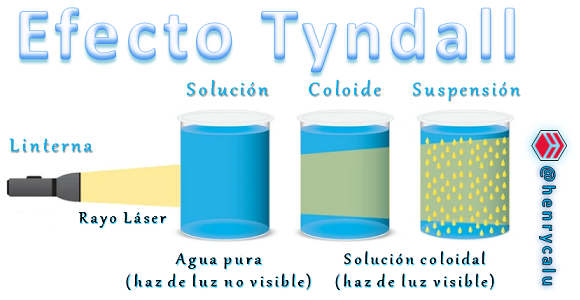
La experiencia de Tyndall o experimento del rehielo:

En esta experiencia un hilo de alambre del cual penden dos objetos pesados a cada extremo, que va cortando un bloque de hielo colocado sobre dos soportes; la presión del hilo de alambre, derrite momentáneamente el hielo en el lugar de apoyo, pero el agua se vuelve a helar después de pasar el hilo, de tal manera que el bloque de hielo queda nuevamente unido al final del experimento.
Desde el punto de vista de la medicina, el hielo tiene múltiples aplicaciones terapéuticas; en los casos de vómitos, hemorragias gástricas y Hemoptisis, se dejan disolver pequeños trozos en la boca. Colocado en bolsas especiales de goma, se usa como antiflogístico en las apendicitis, Anexitis y otros procesos inflamatorios. En estos casos, siempre se debe interponer entre la bolsa de hielo y la piel un paño delgado, espolvorear la piel con talco e interrumpir la aplicación varias veces en el día a fin de evitar la congelación de la piel, de difícil curación.
El usar hielo en ciertas circunstancias puede traer diversos beneficios a nuestro organismo. El agua al pasar del estado líquido al sólido (hielo), no se alteran sus propiedades. Contiene: Calcio, Sodio y Magnesio (proporciona pequeñas cantidades de mineral para el organismo); no suministra calorías ni vitaminas, tampoco contiene carbohidratos dentro de sus propiedades nutritivas. Pero dentro de su utilidad, posee diversos beneficios como el refrescar o hidratar el cuerpo, en ciertas ocasiones se utiliza para “bajar la fiebre”, ya que puede regular la temperatura corporal si es correctamente aplicado en la zona que presenta alta temperatura, es decir que al ser aplicado (no directamente, se usa con una bolsita especial o pañito para cuidar la piel del frío) sobre la cabeza, en la nuca o en las axilas, ayuda a normalizar la función del Hipotálamo. Otros de sus beneficios, es que puede aliviar el dolor por algún golpe, reducir la inflamación que ha sido provocada luego de una intervención quirúrgica, contusión o simplemente combate el dolor causado por quemaduras, picaduras de insectos; también detiene la sensación de ardor o picadura intensa debido al frío que emana del mismo. Esta última característica se puede usar para desaparecer el Hipo, el frío hacer que el diafragma se relaje disipando las contracciones espasmódicas.
Y así, como todas las anteriores sugerencias de usos y beneficios, existen otras que llevan hasta la versatilidad y eficacia cuando se utiliza en la cocina por ejemplo (cocinar o refrigerar alimentos), o cuando deseamos desprender el chicle de la ropa (complemento de limpieza), o también para hacernos tratamiento de granos y espinillas producidas por el acné (tratamiento estético), conservar productos químicos u órganos para trasplantes (hielo medicinal). Concluyendo que la utilidad del hielo va más lejos que tan sólo acompañar cócteles y enfriar bebidas refrescantes.

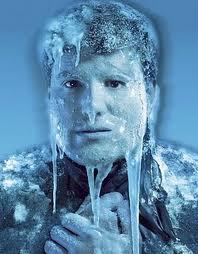

Y recuerde practicar siempre
el amor por la naturaleza,
el Creador del Universo
¡ te lo recompensará !
✧✦✧ @henrycalu ✧✦✧

Ice properties and characteristics
When we are in a meeting and we want to start a personal conversation with other people or guests, many times we do not know how to start the conversation. It is commonly said "to break the ice", because in some cases we panic when speaking in public, or we are subtly embarrassed to address the audience that we do not know, making it difficult to enter and interrupt the atmosphere of conversation. This section has served to "break the ice" and gives way to the definition of "water converted into a solid and crystalline body by a sufficient decrease in temperature or by an increase in pressure".
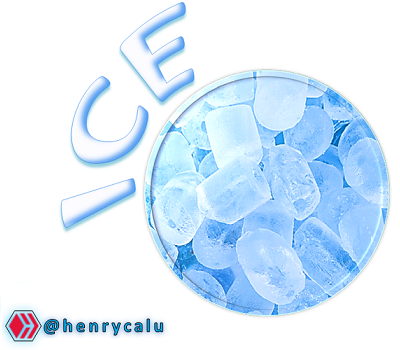
Geologically, we can speak of natural ice, that which was formed millions of years ago in the polar ice caps. The Glacier is more than a thousand meters thick, which covers extensive regions and whose movement takes place towards the edges. It has only Moraine bottom and front. But if artificial ice is mentioned, the version of a common (homemade) ice made in bars is being exposed. Among the household appliances there is an apparatus called refrigerator (fridge, icebox, freezer, etc.); in which buckets filled with water (surrounded by a cooling coil) are placed and when they cool down, ice cubes are obtained.
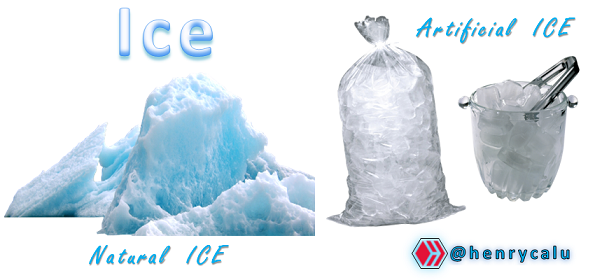
In many parts of the world there is a great variety of techniques for making ice. An example of this is in India: in some places, ice is obtained by leaving porous vessels called "Chattis" outdoors at night.
On an industrial scale, bar ice up to 100 kg can be obtained by cooling water contained in parallelepiped molds by means of brine, calcium chloride solutions at -18°C. The resulting ice is usually more or less opaque because of the small air bubbles it contains; moreover, if the water is not distilled, the salts concentrate in the core of the frozen block, forming the "heart of the ice".
Modern flake ice is produced continuously in a highly refrigerated drum partially submerged in water.

It has another name: dry ice. It is a technique of making a type of ice that is simply solidified Carbon Dioxide (also known as carbon dioxide), which results from compressing carbon snow. It has a great refrigerating power of 152 fg (frigories) per kilogram, almost double that of common ice, but its cost is very high. However, it has the advantage that when heated (it does not melt) it transforms directly into gas. It is used by industry, especially to refrigerate food products for relatively short periods of time.
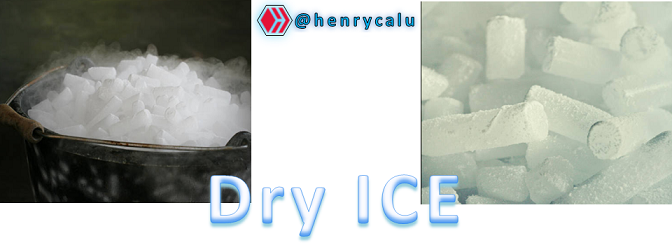
Exposed from a chemical point of view, ice can be said to be solid water. Allotropic modifications exist, and some of them, obtainable at high pressures and temperatures higher than 0°C, are denser than water. Common ice melts at 0°C (by definition of the zero point of the centigrade scale) and at that temperature has a density of 0.9175 g/cm3. It is transparent and colorless or, under considerable thickness, slightly bluish.
In the crystal lattice, each oxygen atom is surrounded by four other oxygen atoms, located in relation to the first one like the vertices of a tetrahedron with respect to its center. On the connecting lines between each oxygen atom and those surrounding it are hydrogen atoms (one on each line). For each oxygen, two of the hydrogens are close together, forming with it the water molecule, and the other two are close to other oxygens; each hydrogen is thus covalently bonded to an oxygen, with which it forms part of a water molecule, and by electronic bonding (hydrogen bonding) it is bonded to another more distant oxygen, belonging to another water molecule. This structure extends along the entire length of the crystal, in all three dimensions.

Photograph showing details of an ice cube under magnification.
1h ice is the form of ice commonly seen on Earth.
Since ice is less dense than liquid water, it decreases in volume as it melts; moreover, its melting point decreases as pressure rises, which explains the phenomenon of glacier movement, and some demonstrative experiences such as that of John Tyndall, illustrated in the following image:

Tyndall's experience or re-ice experiment:
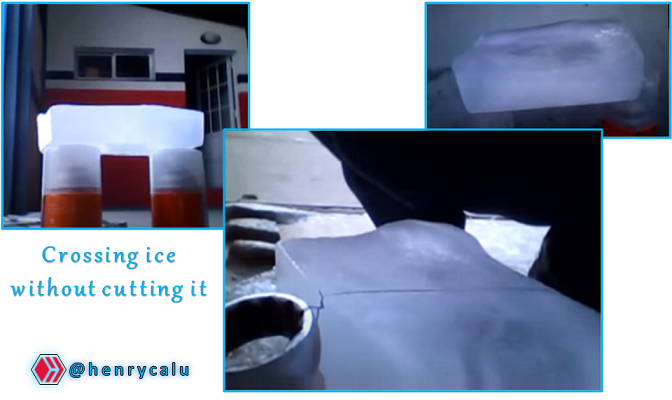
In this experiment, a wire thread from which hang two heavy objects at each end, which cuts a block of ice placed on two supports; the pressure of the wire thread momentarily melts the ice in the place of support, but the water freezes again after passing the thread, so that the block of ice is again united at the end of the experiment.
From the point of view of medicine, ice has multiple therapeutic applications; in cases of vomiting, gastric hemorrhages and Hemoptysis, small pieces are left to dissolve in the mouth. Placed in special rubber bags, it is used as an antiphlogistic in appendicitis, Adnexitis and other inflammatory processes. In these cases, a thin cloth should always be placed between the ice bag and the skin, sprinkle the skin with talcum powder and interrupt the application several times during the day to avoid freezing of the skin, which is difficult to heal.
The use of ice in certain circumstances can bring several benefits to our organism. When water changes from a liquid to a solid state (ice), its properties are not altered. It contains: Calcium, Sodium and Magnesium (provides small amounts of minerals for the body); it does not provide calories or vitamins, nor does it contain carbohydrates within its nutritional properties. But within its usefulness, it has several benefits such as cooling or moisturizing the body, sometimes it is used to "lower the fever", as it can regulate body temperature if properly applied in the area that has high temperature, that is to say that when applied (not directly, it is used with a special bag or handkerchief to protect the skin from cold) on the head, neck or armpits, helps to normalize the function of the Hypothalamus. Another of its benefits is that it can alleviate the pain caused by a blow, reduce the inflammation that has been provoked after a surgical intervention, contusion or simply combat the pain caused by burns, insect bites; it also stops the burning sensation or intense stinging due to the cold that emanates from it. This last characteristic can be used to disappear the Hiccups, the cold makes the diaphragm relax dissipating the spasmodic contractions.
And so, as all the above suggestions of uses and benefits, there are others that lead to the versatility and effectiveness when used in the kitchen for example (cooking or refrigerating food), or when we want to remove chewing gum from clothes (cleaning complement), or also to treat pimples and blackheads caused by acne (aesthetic treatment), preserve chemicals or organs for transplants (medical ice). Concluding that the usefulness of ice goes further than just accompanying cocktails and cooling refreshing drinks.



Thank you for reading this publication !
And remember to always practice
the love of nature,
the Creator of the Universe
will reward you !
✧✦✧ @henrycalu ✧✦✧

C O N S U L T A S (Inquiries)
⇰ Hielo 1h (Ice 1h)
⇰ Hielo (Ice)
⇰ Conoce las propiedades del hielo
(Learn about the properties of ice)
⇰ Cinco usos del hielo que no conocías
(Five uses of ice you didn't know)
¡Gracias!
Thank you!


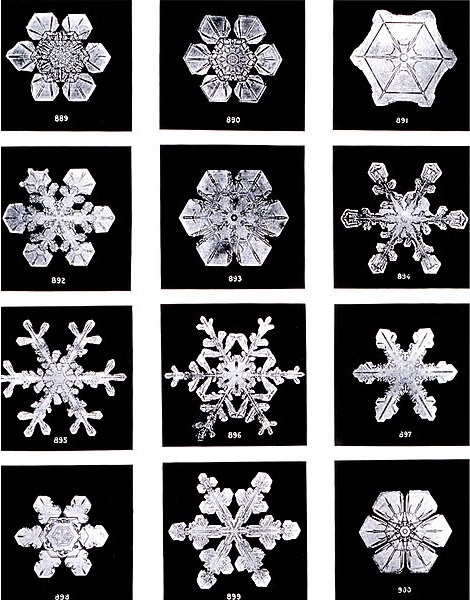

Muy interesante, siempre compartes cosas fuera de lo común ☺️, gracias por los aportes amigo
De eso se trata...!
Investigar temas muy pocos publicados por este medio social. Aún así los votos y comentarios son muy bajos. Pero ya ni me interesa, porque no es mi trabajo; simplemente es una experiencia que hago con mucho cariño y lo publico para compartir con todos los usuarios...
Gracias mi buen amigo @edwing357 por leer y comentar valorando mi trabajo de investigación.
Mantén la constancia amigo , debemos continuar con buen ánimo 😊✍️
Así lo haré. Gracias!
Pa Lante amigo 💯😎
¡Hey mi pana!
@edwing357 ya son 848 votos... ¡Buenísimo! 😊
Excelente! te lo dije jajaja, saludos y buen fin de semana, yo ando trabajando mis recetas para compartirles hoy o mañana 😁
Bien por tí...!
Dios te cuide!
Amén amén 🙏
Nice post : )
Thanks!
¡Interesante!
Bueno, con tantos beneficios, es mejor romper el hielo cuando sea necesario... NAda mas...
Los demás que se ganen mi confianza
¡Buenísimo comentario!
Muchísimas gracias @alummno
Su post ha sido valorado por @ramonycajal
Muchísimas gracias @ramonycajal
Que tema interesante, gracias por compartir.
🤗
Muchas gracias a usted por comentarlo.
Con el apoyo de la familia.
También nos puedes apoyar en nuestro Trail de TopFiveFamily
Si desea delegar HP al proyecto de la Familia del Top Family puedes hacerlo desde aquí: Delegue 5 HP - Delegue 10 HP - Delegue 20 HP - Delegue 30 HP - Delegue 50 HP - Delegue 100 HP.
En apoyo al #toptres de @topfivefamily
https://twitter.com/48474117/status/1626899544360321026
https://twitter.com/311090214/status/1627087718315601920
The rewards earned on this comment will go directly to the people( @lanzjoseg, @marielarc07 ) sharing the post on Twitter as long as they are registered with @poshtoken. Sign up at https://hiveposh.com.
Aprendí muchas cosas que desconocía sobre algo tan común como el hielo.
Gracias por compartir!
Saludos
Ésa es la idea!
Que cada artículo publicado permita incrementar nuestros conocimientos de cultura general
Gracias a usted por su valioso aporte a mi trabajo de investigación.
Saludos @jordy0827
Un tema bien interesante.
Gracias por compartir.
Apoyando el Top3
Agradecido por su comentario Sr @josegilberto
Thanks for your contribution to the STEMsocial community. Feel free to join us on discord to get to know the rest of us!
Please consider delegating to the @stemsocial account (85% of the curation rewards are returned).
You may also include @stemsocial as a beneficiary of the rewards of this post to get a stronger support.
apoyando
Gracias!
!PIZZA :)
Ice is so important especially in a hot country like mine! 😁 !PIZZA
I gifted $PIZZA slices here:
@blitzzzz(15/20) tipped @henrycalu (x1)
Learn more at https://hive.pizza!
Congratulations your publication has been chosen among the best of the day.
KEEP CREATING GOOD CONTENT.
Una buena investigación!
Este es un artículo bastante original por su tema muy poco expuesto en redes sociales en forma de blog. Me agradó saber de las características que posee el hielo que jamás me había puesto a detallar; además de todas esas propiedades tan variadas y versátiles, como para todo uso... Uno de los detalles aprendidos es el que mencionas: "Hielo Medicinal", aunque no le diste un espacio más amplio, tan sólo lo mencionas, pero expones fielmente su gran importancia... Gracias @henrycalu por publicar y compartir tan importante información.
This is a very original article because of its topic, very little exposed in social networks in the form of a blog. I was pleased to learn about the characteristics of ice that I had never detailed before; in addition to all those properties so varied and versatile, as for all uses... One of the details I learned is the one you mention: "Medicinal Ice", although you didn't give it a wider space, you only mention it, but you faithfully expose its great importance... Thank you @henrycalu for publishing and sharing such important information.
Excelente artículo que da a conocer variada información sobre el hielo, @henrycalu
Congratulations @henrycalu! You have completed the following achievement on the Hive blockchain And have been rewarded with New badge(s)
Your next target is to reach 10000 upvotes.
You can view your badges on your board and compare yourself to others in the Ranking
If you no longer want to receive notifications, reply to this comment with the word
STOPCheck out our last posts: